Google for a While the Town Was United Again With Football Why Was This Possible
Introduction
Ball possession, in contempo years, has acquired transcendental importance in the offensive game model of many football teams. This circumstance was mainly acquired by the success of teams such every bit the FC Barcelona, Manchester Urban center, FC Bayer München or the Spanish and German national teams. All these teams are characterized by an offensive game model, based on the initiative of the game, through brawl possession. Numerous previous works have confirmed that it is a performance indicator that makes it possible to differentiate high-level teams. Grant et al. (1999b) analyzed the 1998 World Cup, concluding that greater ball possession is linked to the team success. The piece of work of Hook and Hughes (2001) showed how successful teams in the UEFA Champions League, World Champions and Europa Cup maintained longer possessions than unsuccessful teams. Bloomfield et al. (2005) reported that the three best teams of the English Premier League in the 2003–2004 season (Chelsea FC, Manchester United FC and Armory FC), maintained longer possession time than their opponents. Jones et al. (2004) plant significant differences in possession fourth dimension between successful and unsuccessful teams in the English language Premier League. Carling et al. (2005) analyzed the same competition only in the 1996–1997 season, obtained the aforementioned results. Casal et al. (2015) analyzed Euro 2008, concluding that a longer elapsing of the offensive phase predicts a greater success of it. The analysis of possession in the 2016 UEFA Euro France fabricated in the work of Casal et al. (2017), too corroborate the close relationship between longer possession time and squad success.
In previous works quantitative analysis of possession are carried out, arriving in some cases to identify the zone in which information technology takes place (Casal et al., 2017), but in none of them the factors that modulate team possession time are identified, nor are they compared to admit if these are the same in successful and unsuccessful teams. Therefore, a study that allows to create relationships between the quantitative and qualitative aspects of possession is justified, and that is not express to describing and quantitatively comparing squad possessions, but that tries to place which are the performance indicators related to possession time and, describe an offensive playstyle that allows to guarantee greater longer possessions. Unlike nearly of the previously mentioned works, we intend to perform a novel analysis, from a mixed methods perspective. In this work, in addition to a quantitative analysis, nosotros intend to deport out a qualitative analysis to written report the quality of team possessions. The study of possession quality must be undertaken from a qualitative perspective, and the ideal selection is systematic observation (Anguera et al., 2000, 2017), which guarantees a perfect rest between flexibility and rigor, and which must be integrated with conventional quantitative information in the study of possessions. Thus, this study is considered from the mixed methods perspective, which implies a novel treatment of possessions, which were commonly studied merely from a quantitative perspective, taking into account parameters obtained in many cases through computer programs oriented exclusively to a clarification of the competitions from chemical element frequency (serves, shots on goal, penalties, etc.) of dissimilar nature along the game sets. We start from the mixed methods perspective considering it represents a third emerging paradigm of research (Johnson et al., 2007) that offers an alternative to purely qualitative or quantitative studies which has expanded rapidly over the last 2 decades (Tashakkori and Teddie, 1998, 2003, 2010).
Through the application of this methodology nosotros will try to achieve the following objectives: determining possession times of successful and unsuccessful teams, identifying performance indicators that influence possession times in both groups of teams, describing differences between possession patterns of successful and unsuccessful teams and, finally, find more effective possession models. Our hypothesis is that possession analysis from the mixed methods perspective volition brand possible to place a playstyle that guarantees a more than effective possession of the brawl. If the hypothesis is confirmed, obtained results tin can be used by technicians and players to model training and competitions, allowing to increment the offensive performance of teams.
Materials and Methods
Observational Pattern
The specific pattern corresponding to this systematic observation, according to Anguera et al. (2011), is a combination of a nomothetic/puntual/multidimensional (North/P/M) and nomothetic/follow up/multidimensional (N/F/Thousand) design. The reason is that some teams (nomothetic) are recorded in several matches with dissimilar contrary team (puntual), merely as well that these teams participate in the rounds until the concluding match (follow up); in all matches we have considered several functioning indicators and fourth dimension measures (multidimensional). Moreover, the recording used an intrasessional follow-up (frame-by-frame analysis of unlike matches), and was captured using the advertising hoc ascertainment instrument in unlike matches. Data analyzed is of type IV (Bakeman, 1978).
Participants
To control some of the situational variables that can potentially affect tactical and strategic team behavior, such every bit quality or level of opposing teams and the match location (Kormelink and Seeverens, 1999; Carling et al., 2005), 14 teams and 12 matches corresponding to the round of 8th-finals, quarter-finals, semi-finals and final of the 2016 UEFA Euro France have been selected in which 2,636 offensive sequences occurred. Kingdom of belgium, Croatia, Eire, England, French republic, Deutschland, Republic of hungary, Iceland, Italy, Northern Ireland, Portugal, Slovakia, Espana, and Wales were the teams analyzed.
Three games Switzerland vs. Poland; Poland vs. Portugal and Federal republic of germany vs. Italy have been excluded from the analysis since the match upshot was a draw having in account regular fourth dimension and extensions, which makes incommunicable to characterization the teams equally successful or unsuccessful.
This sample ensures that all matches are played on neutral basis, the teams have a similar level and, by eliminating the games of the group phase, we also make sure that the teams await for the victory in their matches, since defeat will mean emptying. In the group phase matches, information technology may happen that some squad is more interested in drawing or losing any of their matches, to avoid a item opponent in the following phases, this would lead to incorrect results in the study.
Observational Instrument
Four national coaches and experts in football research designed an ad hoc ascertainment musical instrument combining a field format and category systems (Anguera et al., 2018a,b) was created (Table 1). Indicators that stand for the qualitative side of this study take been selected based on previous studies (Casal et al., 2015, 2016, 2017), which accept demonstrated their relationship with team performance.
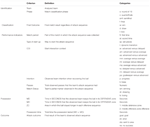
Table 1. Observational instrument (field format combined with category systems).
Information were recorded and coded in the LINCE software program (Gabin et al., 2012), and the MASS packages take been used (Venables and Ripley, 2002), and Auto (Flim-flam and Weisberg, 2011) from the R software (v. 3.4.1).
Procedure
Matches were recorded from Goggle box emitted images and were registered and analyzed post-event. Considering the video recordings were public, confidentiality was not an event and authorization was not required from the players observed or their representatives. Furthermore, the data cannot exist considered either personal or intimate, equally the research consisted solely of naturalistic observations in public places, and information technology was not anticipated that the recordings would be used in a manner that could cause personal harm (The American Psychological Clan'southward [APA's], 2010). No experimental analysis involving man studies is performed in the written report. Also, according to The Belmont Report (1978) the use of public images for research purpose does not required informed consent or the blessing of an upstanding committee. An ethics approval was therefore not required every bit per applicable institutional and national guidelines. Criteria used for the sectionalisation of the teams into two groups, successful and unsuccessful, has been the outcome of the match (Lago-Peñas et al., 2010), excluding penalties. This way, all the teams that won their matches during reglementary time or extensions were classified as successful and teams who lost their matches as unsuccessful.
Data Quality Command
To try to ensure data reliability, all matches were registered and analyzed by four observers, all of them national soccer coaches with more than x years of experience in the field of training, teaching and research in football game through observational methodology. In add-on, the following training process was carried out: Offset, eight observing sessions were conducted on educational activity the observers following the Losada and Manolov (2015) criteria and applying the criterion of consensual agreement (Anguera, 1990) among observers, so that recording was but washed when agreement was produced. To ensure inter-reliability consistency of the data (Berk, 1979; Mitchell, 1979) the Kappa coefficient was calculated for each benchmark, it revealed a strong agreement between observers, which means loftier reliability (0.92), taking Fleiss (1981) as a reference, who establishes a nomenclature for the Kappa values where it characterizes as regular values found betwixt 0.twoscore and 0.60, skilful betwixt 0.60 to 0.75 and excellent above 0.75. Moreover, the procedure was repeated after two weeks (to exclude whatever learning effects) to check intraobserver reliability (Mitchell, 1979).
Statistical Analysis
A complete factorial design was applied to verify which were the factors that most influenced "Possession time" in successful and unsuccessful teams. The analysis of the variables and their interactions was carried out using the ANOVA technique. The residuals conditions were verified to check that normality weather condition are met. In the case of non-compliance, a transformation of the response variable, "Total possession time" was performed, using a Box–Cox transformation where the parameter λ was estimated, by maximum likelihood.
Subsequently adapting the regression model and checking the adjustment to normality by computing the Shapiro–Wilk statistic, the main effects and interaction relationships between the model's significant variables were calculated. Finally, a set of predictions was calculated between the interactions that were significant, accompanied by their graphic representation, to compare successful and unsuccessful teams.
Results
Analysis started with data pick and filtering, using the variables: Type of start-up, Intention, Zc (field zone), Pt (possession time) and Match Condition.
The model proposed for successful teams:
Results obtained from the variance analysis in successful teams are presented in Table ii.
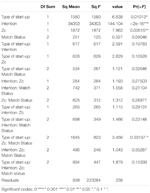
Table 2. ANOVA results for successful teams.
Significant effects in this analysis were: the simple furnishings, Type of beginning-up, Intention, Zc. No significant second-order effects, and only a significant third-order consequence Type of star-up-Zc-Match Condition.
The transformation of the response variable fabricated with the Box–Cox method, offers the best maximization of the likelihood profile, estimating the λ value that in this case is effectually 0.02020202.
This transformation allows to obtain a Shapiro–Wilk test of normality of West = 0.99669 with a p-value = 0.2821, verifying the normality exam of the residuals in the model.
The ANOVA was once more calculated with the transformation, and the post-obit results were obtained (Table iii):
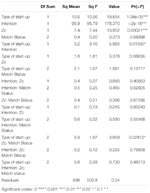
Table 3. ANOVA with transformation.
The significant effects in this assay with the transformation applied were: uncomplicated furnishings, Type of start-upward, Intention, Zc. Significant second-order furnishings, Blazon of commencement-upward-Intention; Type of start-up-Zc. Finally, a third-guild interaction Type of start-upward-Zc-Match Condition was significant.
Principal Furnishings in Successful Teams
The principal furnishings of the three significant simple factors were represented, with their values related to possession time (Figure 1). In this mode, possession fourth dimension with respect to Type of start-up was obtained, and was slightly greater when the get-go is given in a set piece than in transition. With respect to the Zc a greater possession of the ball was observed in the offensive zone. Regarding the factor Intention of the observed team, when information technology recovers the ball, it was observed that the greatest possession time was given in an intention to progress with the ball (p: progress), and somewhat less when the intention was to preserve the ball (thousand: keep). The combination of the three factors with the maximum time of possession would be: in offensive zone, starting from a set up pieces and with the intention of progressing the ball.

Figure one. Master effects in successful teams.
Interactions in Successful Teams
The significant interactions of the model (Type of start-up-Intention; Type of kickoff-upwards-Zc) were shown (Figure two). In the case of the Type of start-up-Intention interaction, it could be seen how, both in the plays that started at set pieces and in transition, the greatest possession fourth dimension occurred when the squad intended to keep the ball.

Figure ii. Interaction Type of start-up-Intention and Blazon of start-up-Zc.
In the Type of commencement-up-Zc interaction, a greater possession time was observed, both in the offensive zone, and the defensive zone, when the offensive phase was initiated past means of a transition.
Successful Teams Predictions
Predictions of the significant interactions in the model were established, based on possession time, obtaining the prediction'south most adapted values, accompanied by their confidence intervals (Tabular array 3).
A showtime prediction was formed by the Blazon of kickoff-up-Intention factors. The values of the categories of the commencement of the sequence were presented in relation to team intention. In Table 4 information technology can be observed, how a greater possession of the ball will be produced when the play begins by means of a transition.

Tabular array 4. Predictions based on possession time.
A 2d prediction configured past the factors Type of start-upwardly-Zc, indicates that at that place will e'er be greater possession of the ball, both in the defensive and offensive zones, if initiated by means of a transition.
For the prediction of iii factors Type of start-up-Zc-Match Condition the following situations were collected (Tabular array five):
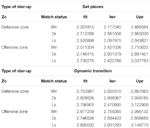
Table 5. Three gene prediction.
If the play is started at set pieces deportment, in that location will be a longer possession time with a tied score, both in the defensive and offensive zones.
In the example of a get-go with transition. There volition be a longer possession time in the defensive zone with the score tied and in the offensive zone with the marker losing.
The model proposed for unsuccessful teams was the same as for successful ones:
Once the lack of normality adjustment to residuals was verified and the transformation of the explained variable was carried out applying the Box–Cox transformation, with a value λ = 0.1414141, which allows obtaining a Shapiro–Wilk coefficient. W = 0.9974, and a p-value = 0.1798, justifying the adjustment of the residuals of the model.
Table 6 shows the results obtained in the variance analysis, with the new adjustment.
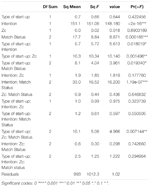
Table 6. ANOVA results with transformed dependent variable, for non-successful teams.
The following significant values were observed: simple effects: Intention (p < 0.001) y Lucifer Status (p < 0.001). Second order effects: Blazon of commencement-upwardly- Intention (p < 0.05); Type of start-up-Zc (p < 0.01); Type of start-up-Match Status (p < 0.05); Intention-Match Condition (p < 0.001). Tertiary gild pregnant effect: Type of start-up-Zc-Match Condition (p < 0.01)
Chief Furnishings for Unsuccessful Teams
The main furnishings were represented, of the ii significant simple factors and their values related to the time of possession (Effigy 3). In this manner, it was observed that the greatest possession time with respect to the Intention gene occurs when there was an intention to keep the brawl (k: keep), and much less when the intention was to progress (p: progress). In the cistron score (Friction match Status), the greatest possession time was given when the team was losing, while the shortest possession fourth dimension was given when the team was winning. The combination of the ii factors point that the maximum possession time is achieved, based on an intention to keep the brawl, when the team is losing.

Figure three. Chief effects for unsuccessful teams.
Unsuccessful Teams Interactions
Figure 4 shows the significant interactions of the model, according to the type of start-up. In the example of the Type of start-up-Intention interaction, it could be observed that, in both types of starts of the play, the longest possession time occurred when the intention was to keep the ball.

Figure 4. Interaction Blazon of start-upwards-Intention; Type of beginning-up-Zc and Interaction Blazon of star-up-Match Status.
In the Type of start-up-Zc interaction, the longest possession fourth dimension was given in the instance of starting with a fix slice in the defensive zone. In the case of start with transition, possession time was the aforementioned in both zones.
In the Type of start-upwardly-Lucifer Status interaction, it was observed how the greatest possession fourth dimension occurred when the squad started the play on set pieces and was losing. The shortest time of possession occurred, both in the start of set actions and transition, with the score in favor. With the score cartoon there were inappreciably any differences in possession time regardless of the form of start of the play.
If nosotros analyze the Intention-Match Condition interaction, we can observe how ii intersections occurred (Figure 5). The draw mark interacted with the winning and losing markers. This is because possession time with a describe score was much greater when the intention was to keep the brawl, whereas when the intention was to progress it decreased considerably. When the score was favorable (winning) shorter possession times occurred, regardless of the squad's intention. With the score losing, the longest possession fourth dimension occurred with the intention of keeping the brawl with a descent when the intention was to progress.

Figure five. Interaction Intention-Match Status.
Unsuccessful Teams Prediction
Table 7 shows the results corresponding to the pregnant interactions with the Type of start-upward. We tin can notice how a longer possession fourth dimension will be produced when the play is initiated past ways of a transition, whether it is intended to proceed or progress.
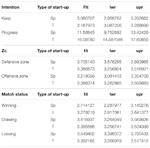
Table 7. Predictions in role to Type of showtime-up.
We can as well observe how, in the defensive zone, greater possession will occur if it is started past means of a set pieces and, in the offensive zone, if it is initiated by means of a transition.
Finally, A greater possession time with the score winning volition occur when the play is initiated by means of a transition. Both with the score losing and cartoon, there will exist a longer possession time when set pieces deportment start.
In Table 8, we present the significant predictions based on Lucifer status. If nosotros analyze the predictions based on team intention and partial upshot we can see how, with the score drawing, at that place will be a longer possession fourth dimension if you attempt to go on the ball and, with the result of losing, there will be a greater possession if you lot try to progress.

Table eight. Prediction according to tactical intention – marking.
For the prediction of three factors (Type of start-up-ZC and Match Condition), the following situations may be possible (Tabular array ix):
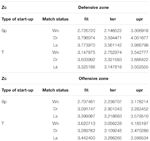
Tabular array nine. Prediction field zone-blazon of offset-upward-marker.
In the defensive zone volition exist greater possession when the score is drawing, whether the play is initiated by means of a transition or fix pieces.
There volition exist greater possession of the ball in offensive zone when the set piece starts with the score losing, and, if it starts with a transition, with the score winning.
Word
Ball possession has been identified as a differentiating performance indicator between successful and unsuccessful teams (Grant et al., 1999a,b; Hook and Hughes, 2001; Jones et al., 2004; Bloomfield et al., 2005; Carling et al., 2005; Hughes and Franks, 2005; Casal et al., 2015, 2017). This work was proposed with the intention of discriminating possession time qualitative and quantitatively in successful and unsuccessful teams from a mixed methods perspective, to try to place an effective ball possession model. The results have immune us to place pregnant differences betwixt ball possession models of both groups of teams.
Specifically, based on the results of the simple furnishings, we have detected that in successful teams possession fourth dimension is influenced past, the class of start of the offensive phase, the intention of the team once possession is recovered and possession zone. Successful teams are characterized past having longer possessions in the offensive zone when they start at gear up pieces actions and with the intention of progressing. On the other paw, in unsuccessful teams possession time of the offensive stage is influenced by team intention, once the possession of the ball has been recovered, and by the match status. In the latter case, our results approve those obtained in previous studies (Sasaki et al., 1999; James et al., 2004; Jones et al., 2004; Bloomfield et al., 2005; Lago-Peñas and Martín, 2007; Taylor et al., 2008; Lago-Peñas, 2009). These teams will have longer possessions when they are losing, results in line with some previous works (Sasaki et al., 1999; Jones et al., 2004; Bloomfield et al., 2005; Lago-Peñas and Martín, 2007; Lago-Peñas, 2009) and with the intention of keeping the ball. Of these results, perchance the most significant is to signal how the partial effect, in successful teams, does not influence possession fourth dimension. Indicating, in this instance, that these teams practise not vary their game model based on friction match condition, while unsuccessful ones practice, coinciding with the results of Bloomfield et al. (2005). These data differ from some of the previously mentioned works since, their results show the aforementioned pattern of ball possession, for both groups of teams, depending on the development of the lucifer condition. This circumstance may signal an development of the game of successful teams toward more stable possession models, and less influenced by the development of the match condition.
If we analyze the results obtained when studying the interaction of the different variables selected with possession time, we tin can observe how in the second order interactions there are also significant differences between both groups of teams. While successful teams are characterized by having longer possessions in the offensive zone, when they beginning possession through a transition, unsuccessful teams have longer possessions in the defensive zone, initiating the assail through ready pieces ball actions and, to a higher place all, when they are losing. We cannot compare these results with previous works, since we accept not institute whatsoever study that performs a multivariate analysis with the indicators selected here. Some previous works (Casal et al., 2017) have too institute that successful teams are characterized by possessions of longer duration in the offensive zone and unsuccessful ones, on the contrary, in the defensive zone. This tin can be explained because successful teams are supposed to take a higher technical-tactical level, and are able to overcome the greater defensive force per unit area and aggregating of players nigh the opposing goal and, on the contrary, unsuccessful teams volition simply be able of maintaining possession in those areas of lower defensive pressure that, in full general, are close to your goal.
Finally, observing the data obtained in third-order interactions, which will let united states of america to make predictions about how possession time of the squad will be, according to the relationships between the selected variables. In this example, we can cheque how the main differences between both teams occur in the following cases:
Successful teams volition always have greater possession time, both in defensive and offensive zone in the event that the play is initiated by means of a transition. These information are in line with what was previously stated when finding that successful teams take longer possession times than unsuccessful ones, indicating that higher-level teams endeavor to command the game, and take the initiative, through ball possession, helped by the loftier individual performances of their players. In the case of unsuccessful teams, if the offensive stage starts on set pieces actions, the greatest possession will occur in the defensive zone and, if the play is initiated by means of a transition, in the offensive zone. This can be explained because, in a gear up pieces action, the opposing team has enough fourth dimension to organize defensively and, therefore, lower level teams will accept greater difficulties to accelerate toward areas closer to the opponent's goal. On the contrary, if they showtime the offensive phase afterward a recovery of the ball, it may exist easier for them to progress to more advanced zones, due to the defensive disorganization of the opposing team, since this is in an open disposition, with greater inter and intra-line space.
If we take into business relationship the type of starting time-up and the match status, successful teams volition produce their greatest possession with a score describe and starting the play by means of a set pieces ball activity. This data shows, once again, the control of the game performed past college level teams, maintaining possession of the ball. In the case of unsuccessful teams, if they are winning, they will have greater possession initiating the play through a transition. Every bit we discussed before, in this circumstance of the game, the opposing team will perform a defensive pressure, because of their need to score as much, and the lower level of unsuccessful teams will not allow them to maintain possession for a long fourth dimension unless they initiate the attack through a dynamic transition, without leaving time for the rival squad to organize defensively. If they find themselves losing or drawing, the possession volition exist longer if the play starts at gear up pieces actions. In this case, the rival team does non have the demand to press defensively, which volition facilitate the team possession.
If we consider the blazon of start-up, the match status and field zone. In this example, nosotros meet how successful teams will e'er have longer possessions initiating the offensive plays past means of a transition and this possession will exist more all-encompassing in the defensive zone if they are drawing and in the offensive zone if they are winning. In the first case, it can be considered a normal behavior, since not having the demand to score so much, can give upward on counterattacks and its main objective tin exist focused on keeping the ball, as a defensive method. The second beliefs is somewhat contradictory, since, if they are winning, it is normal for the opposing team to perform defensive force per unit area and this pressure will exist greater near their goal, so maintaining possession in this zone will be more difficult that to exercise information technology nearly the own goal, where the pressure of the adversary team is smaller. This behavior could be explained by the demand to keep the ball as far as possible from the own goal, to avoid a possible chance of an opponent's goal, in the case of losing the brawl to the opponent. On the other mitt, unsuccessful teams, in the case of being drawing, will always take more than extensive possessions in the defensive zone, regardless of the type of start of the play. In addition, in spite of beingness able to have the will to progress toward the rival goal, information technology lacks the technical-tactical mechanisms necessary for it, hence that it passes great moments of the game in the initial gestation phase of the offensive game. Adversary teams, in this situation, practise non have the need to quickly recover the possession of the brawl, and may allow it to be in the power of the opposing team, merely away from their own goal. For these teams possessions will be of greater duration in the offensive zone, losing, and initiating the play past ways of a set pieces action and winning, by ways of a transition. In the showtime case, the need to score as much, will provoke a more advanced defensive pressure and possession of the ball closer to the expanse of the opposing team's goal. The 2d situation has already been explained previously, in this case the defensive pressure of the rival squad will only permit to take the ball a minimum of time in control, until they are able to make a counterattack.
Based on the results obtained, we can prove how our hypothesis regarding possession assay from the mixed methods perspective was confirmed, which would allow united states to differentiate the possessions of successful and unsuccessful teams and describe a more constructive possession way. The application of the results of this study in the field of intervention will affect the tactical-strategic aspects of the team's game. This knowledge will allow the elaboration of intervention strategies to optimize team possession. However, the results of this work cannot be generalized to all matches and competitions, because just national teams take been analyzed and in a specific competition. Every bit some previous works signal (James et al., 2004; Bloomfield et al., 2005; Tucker et al., 2005; Lago-Peñas and Martín, 2007; Lago-Peñas, 2009; Collet, 2013), the type of competitions influences team possession, therefore, it will be necessary to continue investigating with different samples that cover different competitions to try to generalize the results and effort to identify which are the fundamental elements that differentiate or characterize the offensive possessions of successful teams, with the objective of trying to identify a more constructive possession model.
Conclusion
This work has been carried out with the intention of identifying which are the performance indicators that influence possession time in elite soccer teams, check if these indicators differ between successful and unsuccessful teams and finally, identify a more than effective possession model.
Information technology has been possible to verify the existence of differences between the performance indicators that influence possession time between successful and unsuccessful teams. Specifically, in successful teams possession time is influenced by: Type of commencement-upwardly, intention and field zone. On the other hand, possession time of unsuccessful teams is determined fundamentally by intention and match condition. We have also noted how the phase of the tournament in which the match is played, the match period, the interaction context and the number of passes do not influence squad possession fourth dimension. Finally, the models to execute the offensive stage that guarantee a greater possession of the ball have also been different for both groups of teams.
Data Availability
The datasets generated for this study are available on request to the corresponding author.
Author Contributions
CC developed the project, review the literature, and wrote the manuscript. JL was responsible for performed analysis and the method section. MA wrote office of the manuscript and revised the content critically and RM revised the content and supervised the drafting of the manuscript.
Funding
This piece of work was supported by Spanish government project: La actividad física y el deporte como potenciadores del estilo de vida saludable: Evaluación del comportamiento deportivo desde metodologías no intrusivas (Secretaría de Estado de Investigación, Desarrollo e Innovación del Ministerio de Economía y Competitividad) during the period 2016-2018 (Grant DEP2015-66069-P; MINECO/FEDER, UE), Generalitat Valenciana project: Análisis observacional de la acción de juego en el fútbol de élite (Consellería d'Educació, Investigació, Cultura I Sport) during the period: 2017-2019 (Grant GV2017-004), and also Universidad Católica de Valencia "San Vicente Mártir" project: Estudios en el deporte de élite desde los Mixed Methods: técnicas de análisis de estudios comparativos, during the period 2018 (Grant UCV2017/230-002). Lastly, second, tertiary and 4th authors also admit the support of University of Barcelona (Vice-Chancellorship of Doctorate and Inquiry Promotion).
Conflict of Interest Statement
The authors declare that the inquiry was conducted in the absence of any commercial or financial relationships that could be construed as a potential disharmonize of interest.
References
Anguera, M. T. (1990). "Metodología observacional," in Metodología de la investigación en Ciencias del Comportamiento, eds J. Arnau, Thou. T. Anguera, and J. Gómez (Murcia: Secretariado de Publicaciones de la Universidad de Murcia), 125–236.
Google Scholar
Anguera, M. T., Blanco-Villaseñor, A., Hernández-Mendo, A., and Losada, J. (2011). Diseños observacionales: ajuste y aplicación en psicología del deporte [Observational designs: their suitability and application in sports psychology]. Cuadernos Psicol. Deporte 11, 63–76.
Google Scholar
Anguera, G. T., Blanco-Villaseñor, A., Losada, J. L., and Portell, M. (2018a). Pautas para elaborar trabajos que utilizan la metodología observacional. Anuario Psicol. 48, nine–17. doi: 10.1016/j.anpsic.2018.02.001
CrossRef Full Text | Google Scholar
Anguera, M. T., Blanco-Villaseñor, A., Losada, J. L., Sánchez-Algarra, P., and Onwuegbuzie, A. J. (2018b). Revisiting the difference betwixt mixed methods and multimethods: is information technology all in the name? Qual. Quant. 52, 2757–2770. doi: 10.1007/s11135-018-0700-2
CrossRef Full Text | Google Scholar
Anguera, Thousand. T., Blanco-Villaseñor, Á, Losada, J. 50., and Hernández Mendo, A. (2000). La metodología Observacional en el Deporte: Conceptos Básicos. Lecturas: Educación Física y Deportes.
Google Scholar
Anguera, M. T., Camerino, O., Castañer, M., Sánchez-Algarra, P., and Onwuegbuzie, A. J. (2017). The specificity of observational studies in physical activity and sports sciences: moving frontward in mixed methods research and proposals for achieving quantitative and qualitative symmetry. Front. Psychol. eight:2196. doi: 10.3389/fpsyg.2017.02196
PubMed Abstract | CrossRef Full Text | Google Scholar
Bakeman, R. (1978). "Untangling streams of behavior: sequential analysis of observation data," in Observing Behavior: Data Collection and Analysis Methods, Vol. two, ed. Yard. P. Sackett (Baltimore: University of Park Printing),63–78.
Google Scholar
Berk, R. (1979). Generalizability of behavioral observations: a clarification of interobserver understanding and interobserver reliability. Am. J. Ment. Defic. 83, 412–460.
PubMed Abstruse | Google Scholar
Bloomfield, J. R., Polman, R. C. J., and O'Donoghue, P. G. (2005). Effects of score-line on squad strategies in FA Premier League Soccer. J. Sports Sci. 23, 192–193.
Google Scholar
Carling, C., Williams, A. M., and Reilly, T. (2005). Handbook of Soccer Match Analysis: A Systematic Approach to Improving Performance. Abingdon: Routledge.
Google Scholar
Casal, C. A., Andújar, Thou. A., Losada, J. L., Ardá, T., and Maneiro, R. (2016). Identification of defensive performance factors in the 2010 FIFA World Cup South Africa. Sports four:54. doi: 10.3390/sports4040054
PubMed Abstract | CrossRef Full Text | Google Scholar
Casal, C. A., Losada, J. L., and Ardá, T. (2015). Análisis de los factores de rendimiento de las transiciones ofensivas en el fútbol de alto nivel. Rev. Psicol. Deporte 24, 103–110.
Google Scholar
Casal, C. A., Maneiro, R., Ardá, T., Marí, F. J., and Losada, J. L. (2017). Possession zone as a performance indicator in football. the game of the all-time teams. Front. Psychol. 8:1176. doi: 10.3389/fpsyg.2017.01176
PubMed Abstract | CrossRef Total Text | Google Scholar
Collet, C. (2013). The possession game? A comparative analysis of ball retentivity and team success in European and international football, 2007–2010. J. Sports Sci. 31, 123–136. doi: 10.1080/02640414.2012.7272455
PubMed Abstract | CrossRef Full Text | Google Scholar
Fleiss, J. Fifty. (1981). Statistical Methods for Rates and Proportions. New York, NY: Wiley and Sons.
Google Scholar
Fox, J., and Weisberg, S. (2011). An {R} Companion to Applied Regression, 2d Edn. Thousand Oaks, CA: Sage.
Google Scholar
Gabin, B., Camerino, O., Anguera, M. T., and Castañer, M. (2012). Lince: multiplatform sport analysis software. Proc. Soc. Behav. Sci. 46, 4692–4694. doi: 10.1016/j.sbspro.2012.06.320
CrossRef Full Text | Google Scholar
Grant, A. One thousand., Williams, A. M., and Hocking, K. (1999a). Analysis of successful and unsuccessful teams in the 1999 Women'south World Cup. Insight iii, 10–12.
Google Scholar
Grant, A. 1000., Williams, A. M., and Reilly, T. (1999b). An analysis of the successful and unsuccessful teams in the 1998 World Cup. J. Sports Sci. 17:827.
Google Scholar
Claw, C., and Hughes, Thou. (2001). Patterns of Play Leading to Shots in 'euro 2000'. Cardiff: UWIC.
Google Scholar
James, N., Jones, P. D., and Mellalieu, S. (2004). Possession as a performance indicator in soccer. Int. J. Perform. Anal. Sport four, 98–102. doi: 10.1080/24748668.2004.11868295
CrossRef Full Text | Google Scholar
Johnson, R. B., Onwuegbuzie, A. J., and Turner, L. A. (2007). Toward a definition of mixed methods research. J. Mixed Methods Res. i, 112–133. doi: x.1177/1558689806298224
CrossRef Total Text | Google Scholar
Jones, P. D., James, Due north., and Mellalieu, S. (2004). Possession as a operation indicator in soccer. Int. J. Perform. Anal. Sport 4, 98–102. doi: 10.1080/24748668.2004.11868295
CrossRef Full Text | Google Scholar
Kormelink, H., and Seeverens, T. (1999). Match Analysis and Game Preparation. Spring City, PA: Reedswain.
Google Scholar
Lago-Peñas, C. (2009). The influence of lucifer location, quality of opposition, and friction match condition on possession strategies in professional association football game. J. Sports Sci. 27, 1463–1469. doi: 10.1080/02640410903131681
PubMed Abstruse | CrossRef Total Text | Google Scholar
Lago-Peñas, C., Lago-Ballesteros, J., Dellal, A., and Gómez, M. (2010). Game-related statistics that discriminated winning, drawing and losing teams from the Spanish soccer league. J. Syst. Sci. Med. 9, 288–293.
PubMed Abstract | Google Scholar
Losada, J. L., and Manolov, R. (2015). The procedure of bones training, applied training, maintaining the operation of an observer. Qual. Quant. 49, 339–347. doi: x.1007/s11135-014-9989-seven
CrossRef Full Text | Google Scholar
Mitchell, S. (1979). Interobserver agreement, reliability and generalizability of data collected in observational studies. Psychol. Butlet. 86, 376–390. doi: 10.1037/0033-2909.86.two.376
CrossRef Total Text | Google Scholar
Sasaki, Y., Nevill, A., and Reilly, T. (1999). Home reward: a case study of Ipswich Town football game society during the 1996–97 flavor. J. Sports Sci. 17:831.
Google Scholar
Tashakkori, A., and Teddie, C. (eds). (2010). The Sage Handbook of Mixed Methods in Social & Behavioral Inquiry, 2nd Edn. Thousand Oaks, CA: Sage. doi: ten.4135/9781506335193
CrossRef Full Text | Google Scholar
Tashakkori, A., and Teddie, C. (1998). Mixed Methodology: Combining Qualitative and Quantitative Approaches. Thousand Oaks, CA: Sage.
Google Scholar
Tashakkori, A., and Teddie, C. (2003). Handbook of Mixed Methods in the Behavioral and Social Sciences. Thousand Oaks, CA: Sage.
Google Scholar
Taylor, J. B., Mellalieu, S., James, N., and Shearer, D. A. (2008). The influence of friction match location, quality of opposition, and lucifer status on technical performance in professional association football. J. Sports Sci. 26, 885–895. doi: ten.1080/02640410701836887
PubMed Abstruse | CrossRef Full Text | Google Scholar
The Belmont Report (1978). Upstanding Principles and Guidelines for the Protection of Human Subjects of Research. Washintton: The National Commission for the Protection of Human Subjects of Biomedical and Behavioral Research.
Google Scholar
Tucker, W., Mellalieu, Due south., James, Northward., and Taylor, J. B. (2005). Game location effects in professional soccer: a case study. Int. J. Perform. Anal. Sport 5, 23–35. doi: 10.1080/24748668.2005.11868325
CrossRef Full Text | Google Scholar
Venables, W. N., and Ripley, B. D. (2002). Modern Applied Statistics with S, 4th Edn. New York, NY: Springer. doi: ten.1007/978-0-387-21706-2
CrossRef Total Text | Google Scholar
Source: https://www.frontiersin.org/articles/10.3389/fpsyg.2019.00501/full
0 Response to "Google for a While the Town Was United Again With Football Why Was This Possible"
Post a Comment